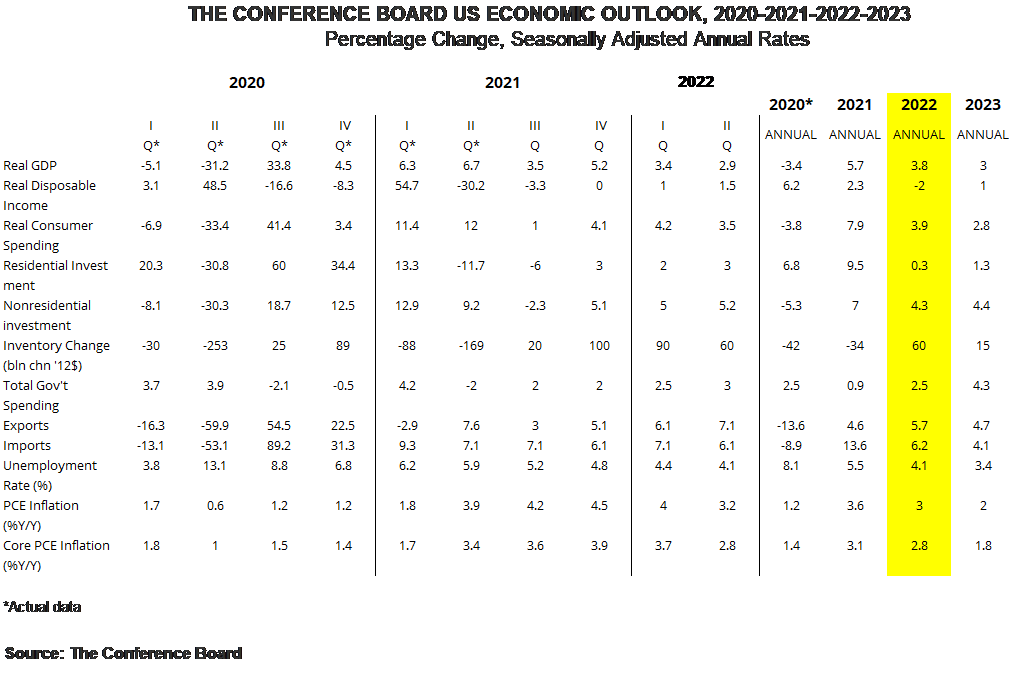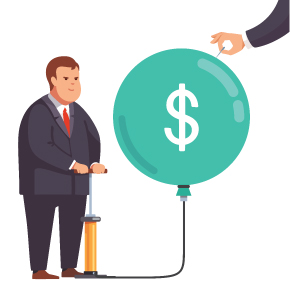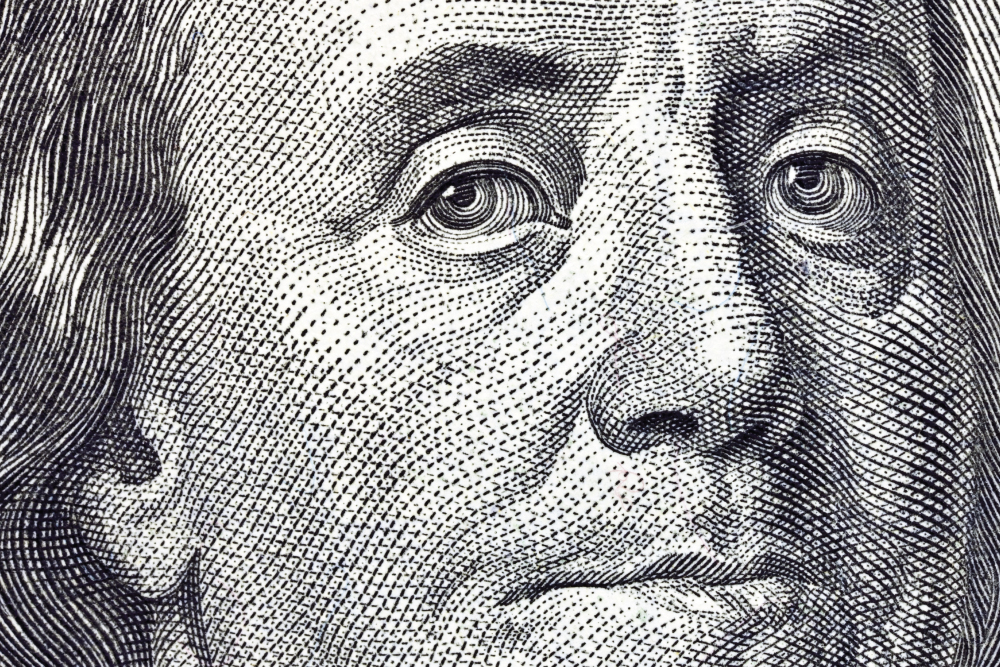A downshift in 2021 - Likely a moderate pace in 2022
A year jump-started with robust economic growth in the United States, 2021’s initially fast recovery shifted to lower gear as inflation worries, the persistence of the COVID-19 Delta variant, and supply chain woes emerged as speed bumps. Some caution flags are raised for 2022—with most economic forecasts seeing around a 4 percent growth rate for real gross domestic product (GDP)—but that’s still
a solid cruising pace.
Real GDP increased at an annual rate of 6.7 percent in the second quarter of 2021, according to the US Bureau of Economic Analysis (BEA). In the first quarter, real GDP increased 6.3 percent. But in the third quarter, the BEA said US GDP growth slowed to just 2 percent—when 2.6 percent was expected.
Many of the same concerns remain in play as the US economy wraps up its fourth quarter and heads into 2022. As such, a number of economic forecasts have been recalibrated—still strong, but somewhat lower.
The Conference Board, for example, is forecasting that US real GDP growth will slow to 3.5 percent (annualized rate) in Q3 2021 and that 2021 annual growth will finish at 5.7 percent, year-over-year.
“This forecast is a downgrade from our September outlook and incorporates the larger-than-expected impact that the COVID-19 Delta variant has had on the US economy,” The Conference Board noted in a mid-October statement. “Looking further ahead, we forecast that the US economy will grow by 3.8 percent (year-over-year) in 2022 and 3.0 percent (year-over-year) in 2023.”
In its latest US forecast, The Conference Board said consumer spending will be a key driver of growth in Q4 2021, but recent declines in consumer confidence related to a resurgence in the pandemic will mute consumption’s contribution to GDP growth in Q3 2021.
“However, as the severity of the Delta wave continues to ebb, we expect spending on in-person services to reaccelerate in the final months of 2021,” the group said.
Bottlenecks in global supply chains made it difficult for businesses to keep up with stronger demand for many goods earlier this year, resulting in a sharp contraction in private inventories.
“We expect this trend to reverse over the coming months as the December holiday period approaches, and forecast a rebound in private inventories,” The Conference Board said. The pace of restocking, however, will be slower than previously anticipated as the Delta variant has hindered manufacturing and shipping activity in key economies around the world.
Inflation seen easing in 2022
Concerns about inflation remain high as businesses and consumers continue to grapple with the impact of the pandemic, emphasized The Conference Board. It sees year-over-year inflation rates staying high through the end of 2021 and into early 2022, followed by some tapering.
“Recent increases in energy prices will also keep inflation from falling more rapidly over the winter months as well,” it noted, “However, the intensity and momentum of month-over-month price increases will likely continue to moderate over the coming months.”  Specifically, The Conference Board sees a year-over-year inflation rate (personal consumption expenditures) of 3.6 percent for 2021, but 3 percent in 2022—and down to 2 percent in 2023.
Specifically, The Conference Board sees a year-over-year inflation rate (personal consumption expenditures) of 3.6 percent for 2021, but 3 percent in 2022—and down to 2 percent in 2023.
Recoveries are never smooth, the widely respected outlook from the UCLA Anderson School of Management noted in its late-September forecast. It contended that the hope for blockbuster economic growth in 2021 was dashed by the spread of the Delta variant and stagnating vaccination rates.
Slightly more bullish than The Conference Board, UCLA Anderson is forecasting 2021 average annual GDP growth of 5.6 percent, down from its 7.1 percent rate predicted in June. For 2022, growth is expected to be 4.1 percent, down from the 5.0 percent rate forecast in June. Going out to 2023, the projection is now 3.1 percent, up from the 2.2 percent rate it predicted in June.
“The reductions in growth for 2021 and 2022 and the increase in growth in 2023 represent a shifting of consumption and investment further into the future,” UCLA Anderson explained in a statement.
What might have been
“What makes this growth ‘ho-hum’ is the comparison to what could have been if, globally, we had gotten COVID under control and had been able to transform pent-up demand, pent-up savings and a tremendous amount of government support into faster economic growth,” wrote UCLA Anderson senior economist Leo Feler in his September forecast. According to Feler, services — not goods — are driving GDP growth. Services consumption remains 1.5 percent below its pre-COVID peak in the fourth quarter of 2019. However, it has been recovering rapidly, faster than the rate of GDP growth, and is therefore one of the drivers powering the recovery.
According to Feler, services — not goods — are driving GDP growth. Services consumption remains 1.5 percent below its pre-COVID peak in the fourth quarter of 2019. However, it has been recovering rapidly, faster than the rate of GDP growth, and is therefore one of the drivers powering the recovery.
Although goods consumption is currently 14.2 percent above its pre-COVID peak, that percentage is shrinking, and goods consumption is no longer a principal driver of the economy. Given supply constraints and the fact that a return to public health restrictions is unlikely, Feler expects consumers to continue their shift away from goods consumption toward services.
The economy is currently down 5.3 million payroll jobs from its pre-COVID peak, and Feler notes there is little evidence to suggest that the expiration of enhanced unemployment benefits will lead to a surge in job applications.
“The forecast is for more gradual gains in employment over the next several quarters,” he added. “We are no longer forecasting average monthly gains over one million. Going forward, we are forecasting average monthly gains of 330,000 in the near term, declining to 170,000 by the end of 2023.”
Supply constraints cloud outlooks
Global supply constraints continue to cap economic output amid growing inflationary and consumer-spending concerns, according to the October 2021 commentary from the Fannie Mae Economic and Strategic Research (ESR) Group.
For the third consecutive month, the ESR Group revised downward its full-year 2021 real GDP growth projections from 5.4 percent to 4.9 percent due to its more pessimistic view of the speed at which current supply chain disruptions will resolve. The ESR team also upwardly revised its inflation projections and expects that services-related consumer spending will take longer to return to a more historically normal level.
“While we still view the supply chain disruptions and, to a lesser extent, labor market tightness as largely transitory, we now expect both to last even longer than we’d previously forecast – and also likely longer than the Federal Reserve anticipated,” said Doug Duncan, Fannie Mae senior vice president and chief economist.
“Combined with our expectation that inflation will run above-target over the forecast horizon, we foresee growing clamor from market participants for the Fed to begin tightening monetary policy,” Duncan added.
Annual inflation, as measured by the Consumer Price Index, is expected to finish 2021 at 5.7 percent, up from the previously projected 5.4 percent, according to Fannie Mae. This is due primarily to elevated energy prices domestically and abroad. To fend off persistently higher inflation, Fannie Mae’s ESR Group expects the Federal Reserve to announce plans to begin tapering its asset purchase program by the end of the year, and it now projects the first federal funds rate hike to take place in the fourth quarter of 2022.
A cooler housing market in view
The ESR Group also highlighted the ongoing impact of supply chain disruptions on housing, including on home price growth and mortgage rate expectations vis-à-vis higher inflation. Mortgage rates are forecast to average 3.3 percent in 2022, up from September’s projection of 3.1 percent, as benchmark interest rates are expected to rise due to increased inflation expectations and a projected tightening of monetary policy.
While Fannie Mae’s ESR Group expects home price growth to decelerate moving into 2022 as the housing market cools from its recent highs, it did revise upward its home price growth forecast by 1.8 points to 16.6 percent for 2021 and 2.3 points to 7.4 percent for 2022. This is as measured by the FHFA Purchase-Only Index and largely reflects persistently tight inventory levels. 
“New single-family home construction remains in high demand but is hindered by many of the same supply constraints, including the availability of both materials and skilled labor, both of which the ESR Group expects will remain obstacles to the delivery of new homes well into next year,” noted the Fannie Mae researchers.
“Even a modest tightening of monetary policy would of course impact housing, but we expect the effects to be largely muted given current market conditions,” Duncan said. “Mortgage rates may rise in response to the tighter environment, but we expect the severe shortage of homes for sale to remain the primary driver of strong house price appreciation through at least 2022, limiting interest rate effects on home sales and home prices.”
Right now, Fannie Mae’s ESR team sees mortgage rates averaging 3.3 percent in 2022. Though slightly higher than 2020 and 2021, rates by historical standards remain extremely low and supportive of mortgage demand and affordability.
CEO moods dampen, small business upbeat
A couple of recently released indicators show a slight dichotomy between the executive suite and Main Street.
In collaboration with The Business Council, The Conference Board also takes the pulse of CEOs on current economic conditions. And after reaching an all-time high in Q2 2021, The Conference Board Measure of CEO Confidence™ retreated in Q3, down to 67 from 82.
A reading above 50 points, however, reflects more positive than negative responses—so 67 is a solidly favorable result. In Q3, 70 percent said conditions are better compared to six months ago, down from 94 percent in Q2. CEOs’ view of conditions in their own industries also retreated, with 64 percent reporting better conditions compared to six months ago, down from 89 percent in Q2.
Looking ahead, expectations softened in Q3 compared to Q2: 60 percent of CEOs expect economic conditions to improve over the next six months, down from 88 percent. Similarly, 65 percent of CEOs anticipate short-term prospects in their own industries to improve, down from 81 percent.
“CEO confidence is down from the all-time peak reached in Q2, when COVID-19 appeared on the verge of defeat,” said Dana Peterson, chief economist of The Conference Board. “A summer surge of the highly infectious Delta variant—coupled with slumping vaccination rates—has brought pandemic uncertainty back to the fore in Q3,” Peterson added. “Nevertheless, optimism remains well above pre-pandemic levels, boding well for employment and investment growth in the months ahead.” Small business owners are feeling optimistic about the near-term future of their businesses amid increasing vaccination rates, and those who report that more than three-quarters of their workforce has been vaccinated are the most positive about their business outlook. This includes expectations for stronger demand, sales and profits than companies reporting a lower rate of employee vaccination, according to PNC Financial Services Group’s semi-annual national small business survey.
Small business owners are feeling optimistic about the near-term future of their businesses amid increasing vaccination rates, and those who report that more than three-quarters of their workforce has been vaccinated are the most positive about their business outlook. This includes expectations for stronger demand, sales and profits than companies reporting a lower rate of employee vaccination, according to PNC Financial Services Group’s semi-annual national small business survey.
Economic optimism linked to vaccine rates
Data gathered through the end of August during PNC’s survey demonstrated that vaccines were top-of-mind for business owners. Some 79 percent of businesses said they have taken action to encourage employee vaccination. Nearly half (48 percent) are requiring employee vaccinations, 44 percent are helping related to vaccinations, 26 percent are incentivizing employees to receive vaccinations, and one in four have added restrictions for employees who choose not to be vaccinated.
“The survey results demonstrate that most business owners believe the vaccine can have a positive impact on their businesses,” PNC Chief Economist Gus Faucher said. “Further, business owner optimism rises as vaccination rates increase, indicating that efforts to support vaccinations broadly could strengthen the economic recovery.”
Despite the optimism among small business owners, challenges remain. While more employers hope to hire – and hiring expectations have returned to pre-pandemic levels – many businesses are struggling to find employees.
Among all employers surveyed, labor availability is the most frequently mentioned concern, topping sales and supply chain worries that were reported as more worrisome earlier in the year. More than four in 10 employers say they are offering increased compensation to retain or attract new employees, implementing employee health or safety improvements (46 percent) and allowing more flexible work arrangements (44 percent).
Profit expectations for the next six months have doubled since PNC’s spring survey, and sales and demand have reached the highest levels in the survey’s 19-year history.





